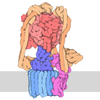[English] 日本語
 Yorodumi
Yorodumi- PDB-7ns3: Substrate receptor scaffolding module of yeast Chelator-GID SR4 E... -
+ Open data
Open data
- Basic information
Basic information
| Entry | Database: PDB / ID: 7ns3 | ||||||||||||||||||||||||||||||||||||||||||||||||||||||||||||||||||||||||||||||||||||||||||||||||||||||||||||||||||||||||||||||||||||||||||
|---|---|---|---|---|---|---|---|---|---|---|---|---|---|---|---|---|---|---|---|---|---|---|---|---|---|---|---|---|---|---|---|---|---|---|---|---|---|---|---|---|---|---|---|---|---|---|---|---|---|---|---|---|---|---|---|---|---|---|---|---|---|---|---|---|---|---|---|---|---|---|---|---|---|---|---|---|---|---|---|---|---|---|---|---|---|---|---|---|---|---|---|---|---|---|---|---|---|---|---|---|---|---|---|---|---|---|---|---|---|---|---|---|---|---|---|---|---|---|---|---|---|---|---|---|---|---|---|---|---|---|---|---|---|---|---|---|---|---|---|
| Title | Substrate receptor scaffolding module of yeast Chelator-GID SR4 E3 ubiquitin ligase bound to Fbp1 substrate | ||||||||||||||||||||||||||||||||||||||||||||||||||||||||||||||||||||||||||||||||||||||||||||||||||||||||||||||||||||||||||||||||||||||||||
 Components Components |
| ||||||||||||||||||||||||||||||||||||||||||||||||||||||||||||||||||||||||||||||||||||||||||||||||||||||||||||||||||||||||||||||||||||||||||
 Keywords Keywords | LIGASE / GID / CTLH / ubiquitin / E3 ligase / supramolecular assembly / metabolism / gluconeogenesis / cryoEM | ||||||||||||||||||||||||||||||||||||||||||||||||||||||||||||||||||||||||||||||||||||||||||||||||||||||||||||||||||||||||||||||||||||||||||
| Function / homology |  Function and homology information Function and homology informationprotein catabolic process in the vacuole / GID complex / : / ascospore formation / traversing start control point of mitotic cell cycle / fructose-bisphosphatase / fructose 1,6-bisphosphate 1-phosphatase activity / vacuole / negative regulation of gluconeogenesis / Neutrophil degranulation ...protein catabolic process in the vacuole / GID complex / : / ascospore formation / traversing start control point of mitotic cell cycle / fructose-bisphosphatase / fructose 1,6-bisphosphate 1-phosphatase activity / vacuole / negative regulation of gluconeogenesis / Neutrophil degranulation / ubiquitin protein ligase activity / carbohydrate metabolic process / proteasome-mediated ubiquitin-dependent protein catabolic process / metal ion binding / nucleus / cytoplasm Similarity search - Function | ||||||||||||||||||||||||||||||||||||||||||||||||||||||||||||||||||||||||||||||||||||||||||||||||||||||||||||||||||||||||||||||||||||||||||
| Biological species |  | ||||||||||||||||||||||||||||||||||||||||||||||||||||||||||||||||||||||||||||||||||||||||||||||||||||||||||||||||||||||||||||||||||||||||||
| Method | ELECTRON MICROSCOPY / single particle reconstruction / cryo EM / Resolution: 3.5 Å | ||||||||||||||||||||||||||||||||||||||||||||||||||||||||||||||||||||||||||||||||||||||||||||||||||||||||||||||||||||||||||||||||||||||||||
 Authors Authors | Sherpa, D. / Chrustowicz, J. / Prabu, J.R. / Schulman, B.A. | ||||||||||||||||||||||||||||||||||||||||||||||||||||||||||||||||||||||||||||||||||||||||||||||||||||||||||||||||||||||||||||||||||||||||||
| Funding support |  Germany, 2items Germany, 2items
| ||||||||||||||||||||||||||||||||||||||||||||||||||||||||||||||||||||||||||||||||||||||||||||||||||||||||||||||||||||||||||||||||||||||||||
 Citation Citation |  Journal: Mol Cell / Year: 2021 Journal: Mol Cell / Year: 2021Title: GID E3 ligase supramolecular chelate assembly configures multipronged ubiquitin targeting of an oligomeric metabolic enzyme. Authors: Dawafuti Sherpa / Jakub Chrustowicz / Shuai Qiao / Christine R Langlois / Laura A Hehl / Karthik Varma Gottemukkala / Fynn M Hansen / Ozge Karayel / Susanne von Gronau / J Rajan Prabu / ...Authors: Dawafuti Sherpa / Jakub Chrustowicz / Shuai Qiao / Christine R Langlois / Laura A Hehl / Karthik Varma Gottemukkala / Fynn M Hansen / Ozge Karayel / Susanne von Gronau / J Rajan Prabu / Matthias Mann / Arno F Alpi / Brenda A Schulman /  Abstract: How are E3 ubiquitin ligases configured to match substrate quaternary structures? Here, by studying the yeast GID complex (mutation of which causes deficiency in glucose-induced degradation of ...How are E3 ubiquitin ligases configured to match substrate quaternary structures? Here, by studying the yeast GID complex (mutation of which causes deficiency in glucose-induced degradation of gluconeogenic enzymes), we discover supramolecular chelate assembly as an E3 ligase strategy for targeting an oligomeric substrate. Cryoelectron microscopy (cryo-EM) structures show that, to bind the tetrameric substrate fructose-1,6-bisphosphatase (Fbp1), two minimally functional GID E3s assemble into the 20-protein Chelator-GID, which resembles an organometallic supramolecular chelate. The Chelator-GID assembly avidly binds multiple Fbp1 degrons so that multiple Fbp1 protomers are simultaneously ubiquitylated at lysines near the allosteric and substrate binding sites. Importantly, key structural and biochemical features, including capacity for supramolecular assembly, are preserved in the human ortholog, the CTLH E3. Based on our integrative structural, biochemical, and cell biological data, we propose that higher-order E3 ligase assembly generally enables multipronged targeting, capable of simultaneously incapacitating multiple protomers and functionalities of oligomeric substrates. #1:  Journal: Biorxiv / Year: 2021 Journal: Biorxiv / Year: 2021Title: GID E3 ligase supramolecular chelate assembly configures multipronged ubiquitin targeting of an oligomeric metabolic enzyme Authors: Sherpa, D. / Chrustowicz, J. / Qiao, S. / Langlois, C.R. / Hehl, L.A. / Gottemukkala, K.V. / Hansen, F.M. / Karayel, O. / Prabu, J.R. / Mann, M. / Alpi, A.F. / Schulman, B.A. | ||||||||||||||||||||||||||||||||||||||||||||||||||||||||||||||||||||||||||||||||||||||||||||||||||||||||||||||||||||||||||||||||||||||||||
| History |
|
- Structure visualization
Structure visualization
| Movie |
 Movie viewer Movie viewer |
|---|---|
| Structure viewer | Molecule:  Molmil Molmil Jmol/JSmol Jmol/JSmol |
- Downloads & links
Downloads & links
- Download
Download
| PDBx/mmCIF format |  7ns3.cif.gz 7ns3.cif.gz | 371.1 KB | Display |  PDBx/mmCIF format PDBx/mmCIF format |
|---|---|---|---|---|
| PDB format |  pdb7ns3.ent.gz pdb7ns3.ent.gz | Display |  PDB format PDB format | |
| PDBx/mmJSON format |  7ns3.json.gz 7ns3.json.gz | Tree view |  PDBx/mmJSON format PDBx/mmJSON format | |
| Others |  Other downloads Other downloads |
-Validation report
| Summary document |  7ns3_validation.pdf.gz 7ns3_validation.pdf.gz | 1 MB | Display |  wwPDB validaton report wwPDB validaton report |
|---|---|---|---|---|
| Full document |  7ns3_full_validation.pdf.gz 7ns3_full_validation.pdf.gz | 1 MB | Display | |
| Data in XML |  7ns3_validation.xml.gz 7ns3_validation.xml.gz | 59.6 KB | Display | |
| Data in CIF |  7ns3_validation.cif.gz 7ns3_validation.cif.gz | 91.6 KB | Display | |
| Arichive directory |  https://data.pdbj.org/pub/pdb/validation_reports/ns/7ns3 https://data.pdbj.org/pub/pdb/validation_reports/ns/7ns3 ftp://data.pdbj.org/pub/pdb/validation_reports/ns/7ns3 ftp://data.pdbj.org/pub/pdb/validation_reports/ns/7ns3 | HTTPS FTP |
-Related structure data
| Related structure data |  12559MC  7ns4C 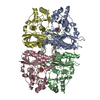 7ns5C  7nsbC  7nscC C: citing same article ( M: map data used to model this data |
|---|---|
| Similar structure data |
- Links
Links
- Assembly
Assembly
| Deposited unit | 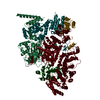
|
|---|---|
| 1 |
|
- Components
Components
-Vacuolar import and degradation protein ... , 2 types, 2 molecules 54
| #1: Protein | Mass: 105609.133 Da / Num. of mol.: 1 Source method: isolated from a genetically manipulated source Source: (gene. exp.)  Strain: ATCC 204508 / S288c / Gene: VID28, GID5, YIL017C / Production host:  Trichoplusia ni (cabbage looper) / References: UniProt: P40547 Trichoplusia ni (cabbage looper) / References: UniProt: P40547 |
|---|---|
| #5: Protein | Mass: 41291.934 Da / Num. of mol.: 1 Source method: isolated from a genetically manipulated source Source: (gene. exp.)  Gene: SCP684_0007018400 / Production host:  |
-Protein , 4 types, 4 molecules 819Fb
| #2: Protein | Mass: 55803.309 Da / Num. of mol.: 1 Source method: isolated from a genetically manipulated source Source: (gene. exp.)  Strain: ATCC 204508 / S288c / Gene: GID8, DCR1, YMR135C, YM9375.04C / Production host:  Trichoplusia ni (cabbage looper) / References: UniProt: P40208 Trichoplusia ni (cabbage looper) / References: UniProt: P40208 |
|---|---|
| #3: Protein | Mass: 108287.680 Da / Num. of mol.: 1 Source method: isolated from a genetically manipulated source Source: (gene. exp.)  Gene: PACBIOSEQ_LOCUS2437, SCNYR20_0003002900, SCP684_0002002900 Production host:  Trichoplusia ni (cabbage looper) / References: UniProt: A0A6L0ZCH7 Trichoplusia ni (cabbage looper) / References: UniProt: A0A6L0ZCH7 |
| #4: Protein | Mass: 59975.102 Da / Num. of mol.: 1 Source method: isolated from a genetically manipulated source Source: (gene. exp.)  Gene: PACBIOSEQ_LOCUS1661, PACBIOSEQ_LOCUS1718 / Production host:  Trichoplusia ni (cabbage looper) / References: UniProt: A0A6A5PZU1 Trichoplusia ni (cabbage looper) / References: UniProt: A0A6A5PZU1 |
| #6: Protein | Mass: 38303.473 Da / Num. of mol.: 1 Source method: isolated from a genetically manipulated source Source: (gene. exp.)  Gene: PACBIOSEQ_LOCUS4585, PACBIOSEQ_LOCUS4655, SCNYR20_0004037500, SCP684_0004037100 Production host:  |
-Details
| Has protein modification | Y |
|---|
-Experimental details
-Experiment
| Experiment | Method: ELECTRON MICROSCOPY |
|---|---|
| EM experiment | Aggregation state: PARTICLE / 3D reconstruction method: single particle reconstruction |
- Sample preparation
Sample preparation
| Component | Name: Substrate receptor scaffolding module of yeast Chelator-GID SR4 comprising Gid1, Gid4, Gid5, Gid8 and Gid9 bound to Fbp1 Type: COMPLEX Details: Generated by focused refinement of Chelator-GID SR4 + Fbp1 map Entity ID: all / Source: RECOMBINANT |
|---|---|
| Molecular weight | Value: 0.31 MDa |
| Source (natural) | Organism:  |
| Source (recombinant) | Organism:  Trichoplusia ni (cabbage looper) Trichoplusia ni (cabbage looper) |
| Buffer solution | pH: 7.5 |
| Specimen | Embedding applied: NO / Shadowing applied: NO / Staining applied: NO / Vitrification applied: YES |
| Vitrification | Cryogen name: ETHANE |
- Electron microscopy imaging
Electron microscopy imaging
| Experimental equipment |  Model: Titan Krios / Image courtesy: FEI Company |
|---|---|
| Microscopy | Model: FEI TITAN KRIOS |
| Electron gun | Electron source:  FIELD EMISSION GUN / Accelerating voltage: 300 kV / Illumination mode: FLOOD BEAM FIELD EMISSION GUN / Accelerating voltage: 300 kV / Illumination mode: FLOOD BEAM |
| Electron lens | Mode: BRIGHT FIELD |
| Image recording | Electron dose: 79.2 e/Å2 / Film or detector model: GATAN K3 BIOQUANTUM (6k x 4k) |
- Processing
Processing
| Software | Name: PHENIX / Version: 1.18.2_3874: / Classification: refinement | ||||||||||||||||||||||||
|---|---|---|---|---|---|---|---|---|---|---|---|---|---|---|---|---|---|---|---|---|---|---|---|---|---|
| EM software | Name: PHENIX / Category: model refinement | ||||||||||||||||||||||||
| CTF correction | Type: PHASE FLIPPING AND AMPLITUDE CORRECTION | ||||||||||||||||||||||||
| 3D reconstruction | Resolution: 3.5 Å / Resolution method: FSC 0.143 CUT-OFF / Num. of particles: 74929 / Symmetry type: POINT | ||||||||||||||||||||||||
| Refine LS restraints |
|
 Movie
Movie Controller
Controller














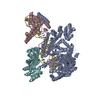
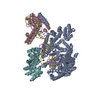
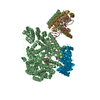
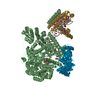






 PDBj
PDBj




